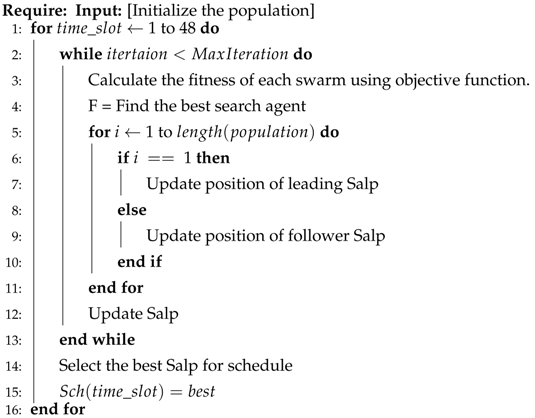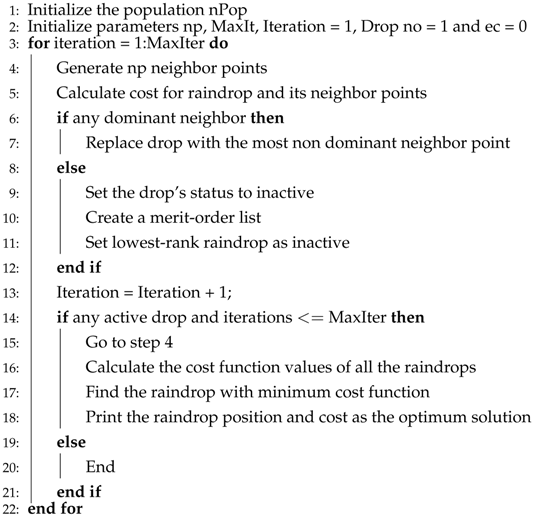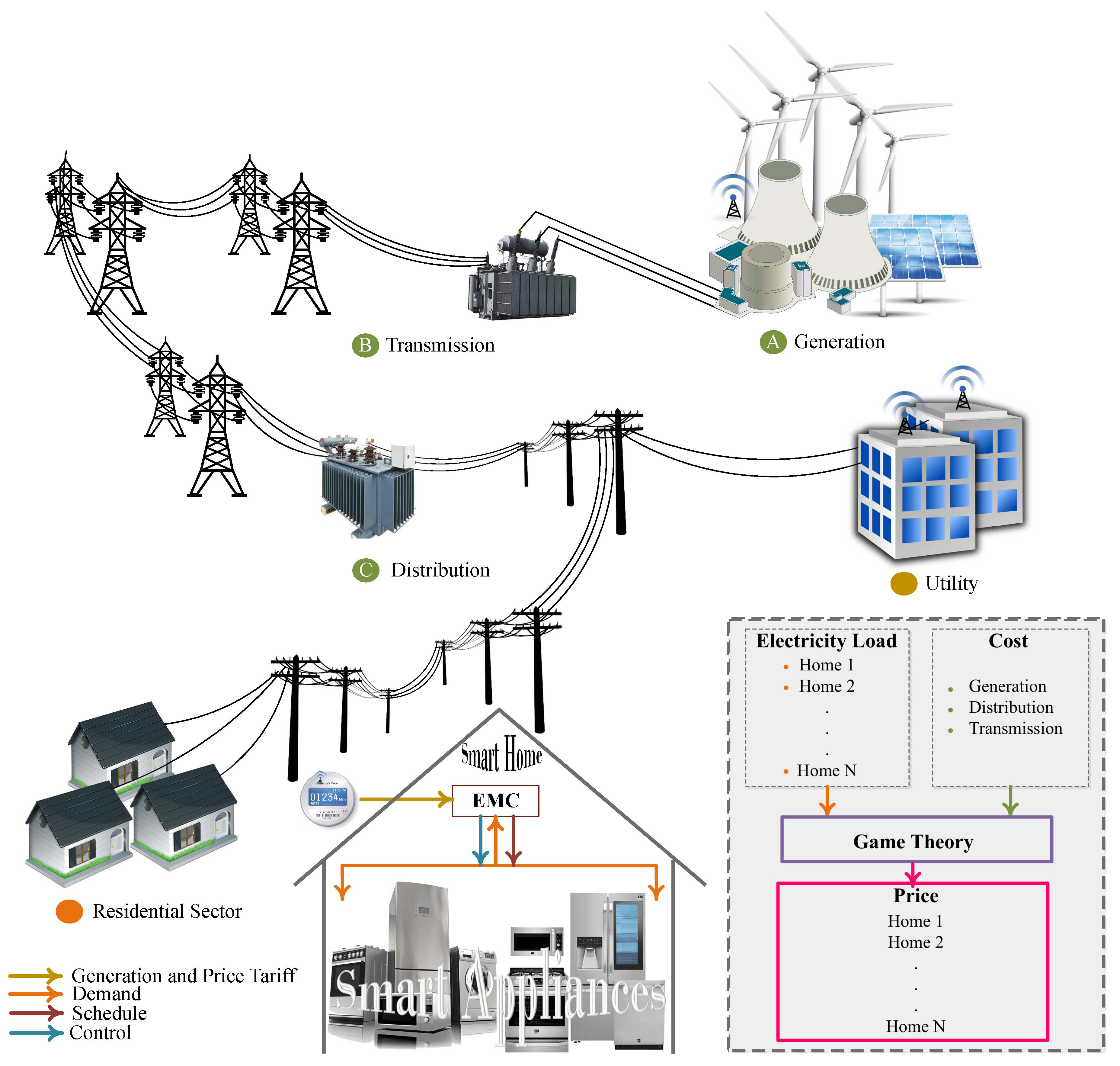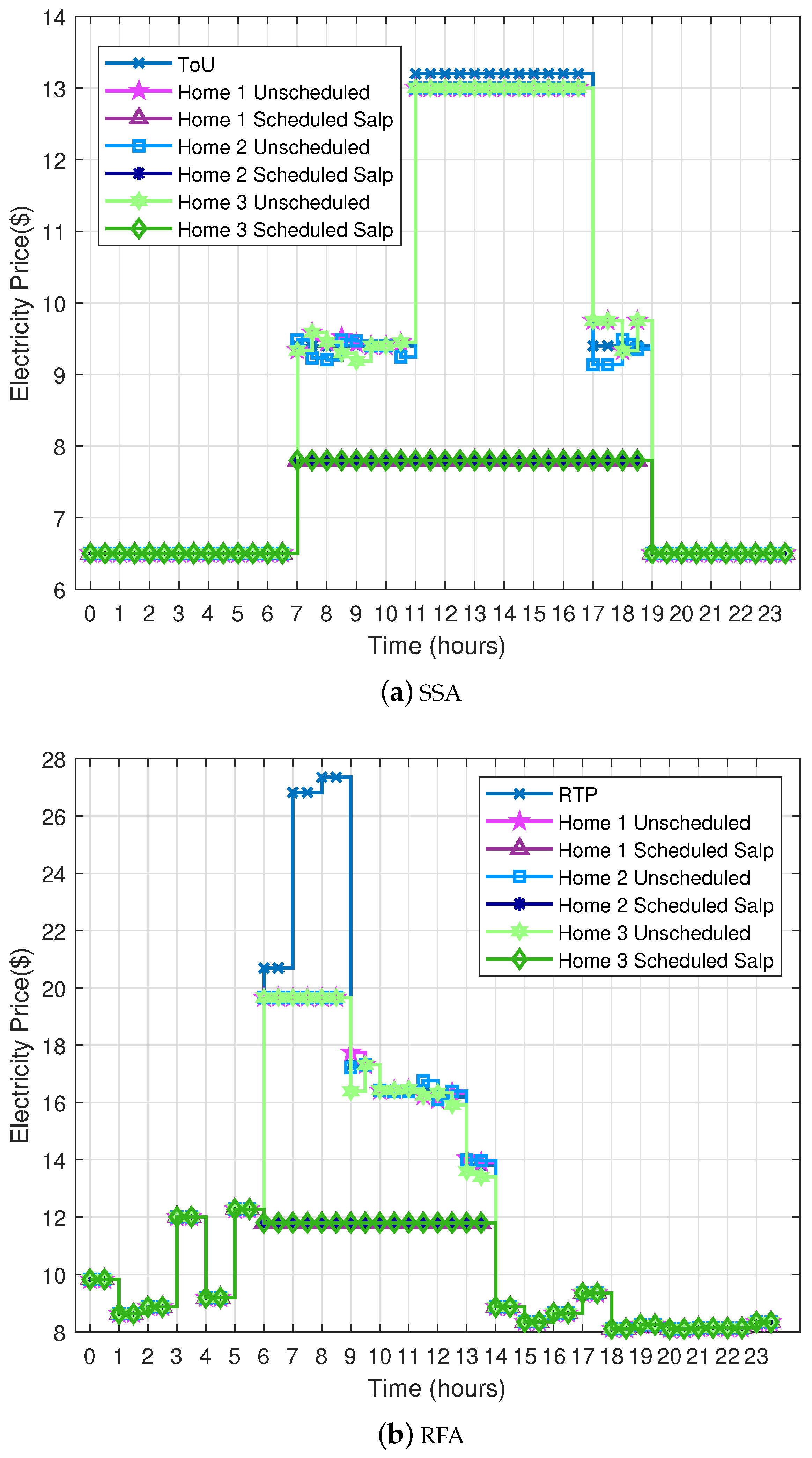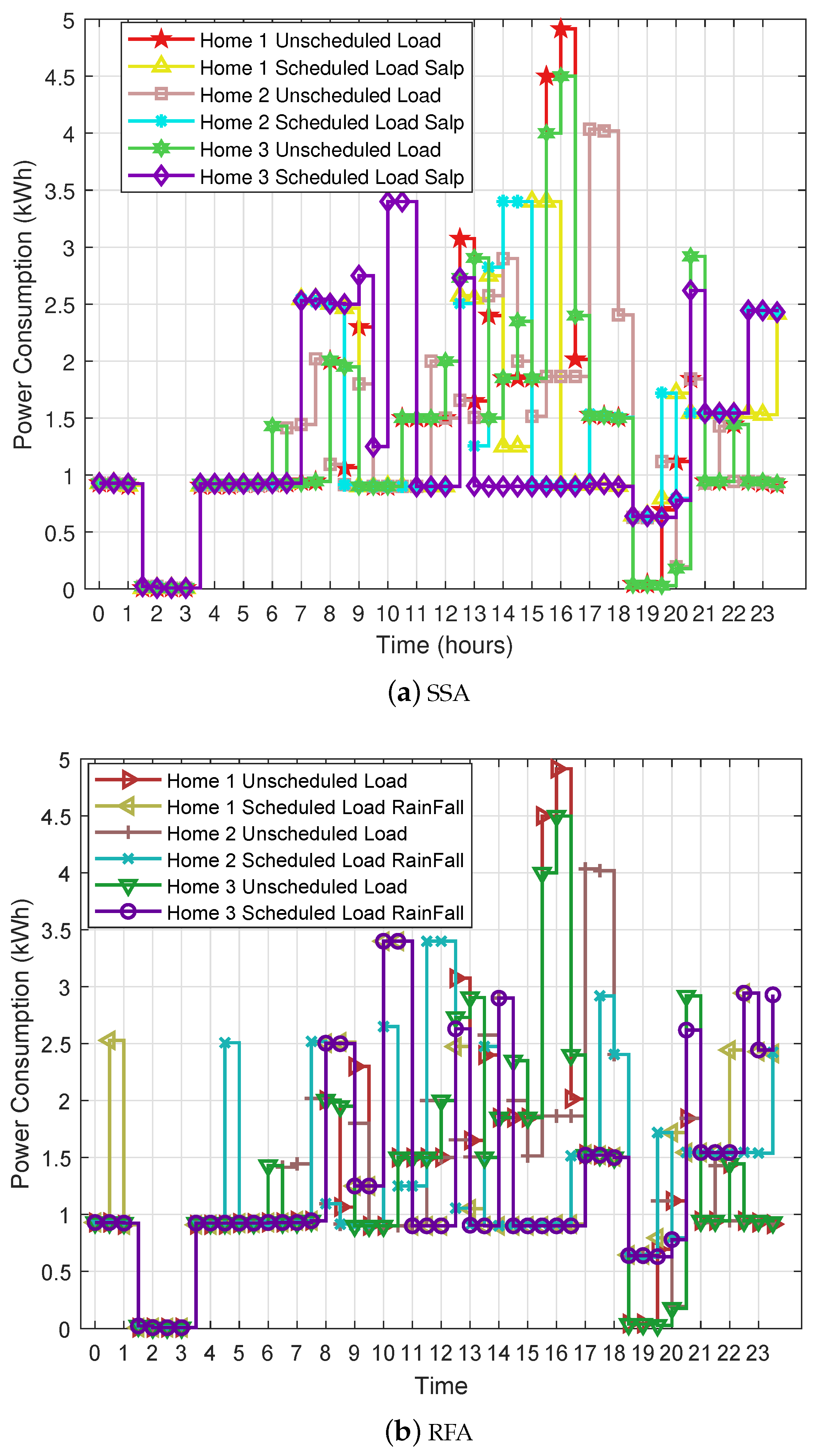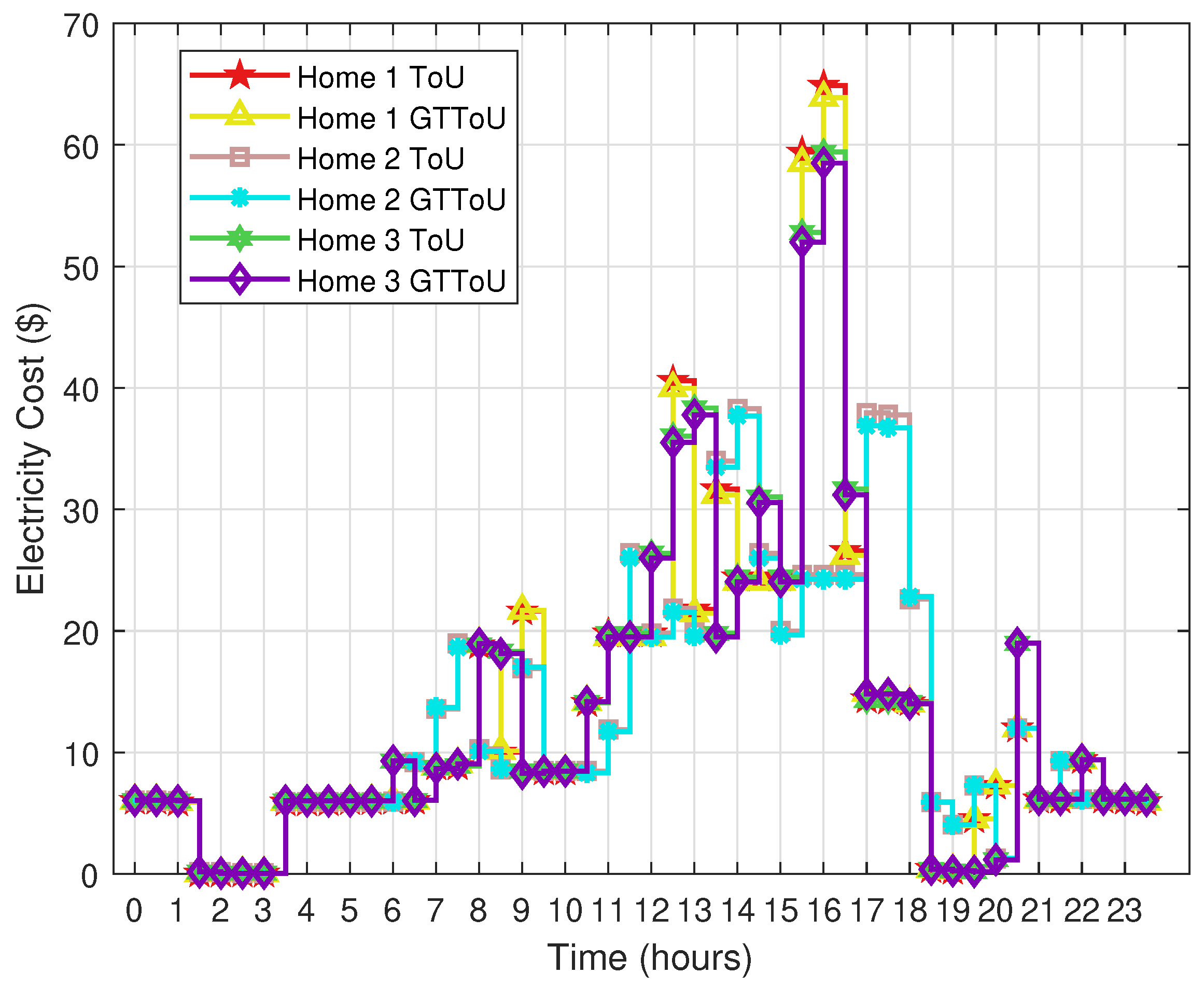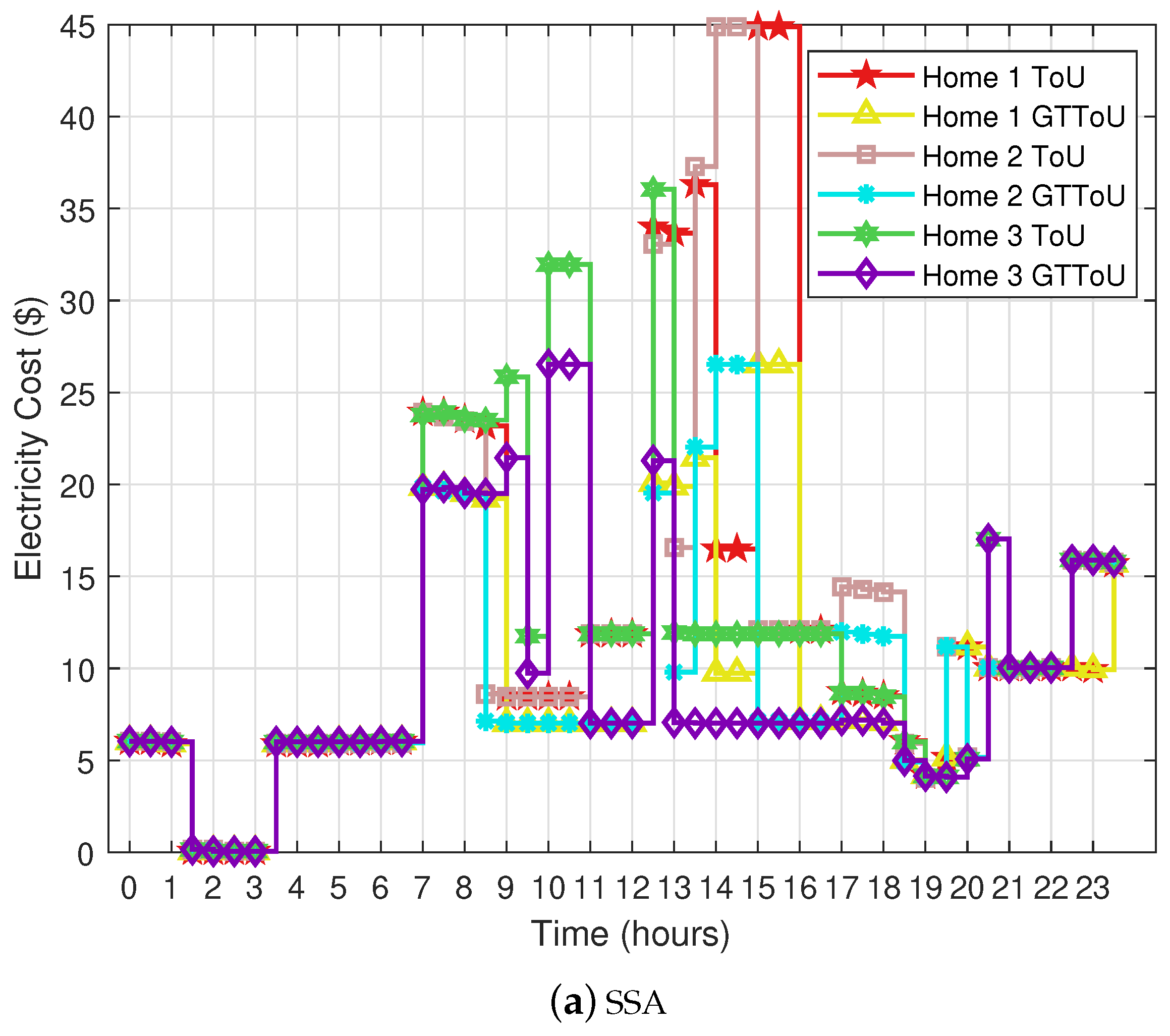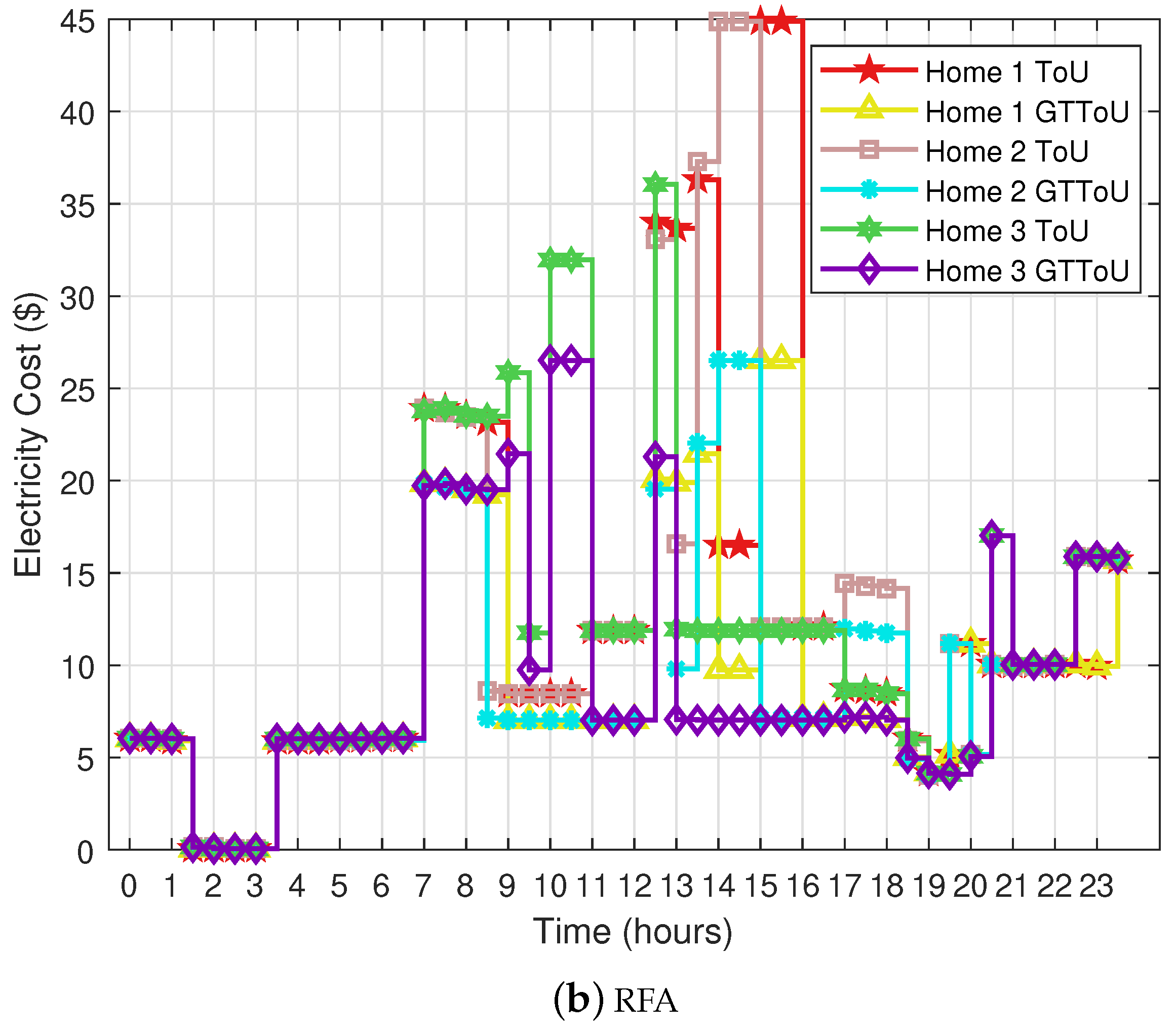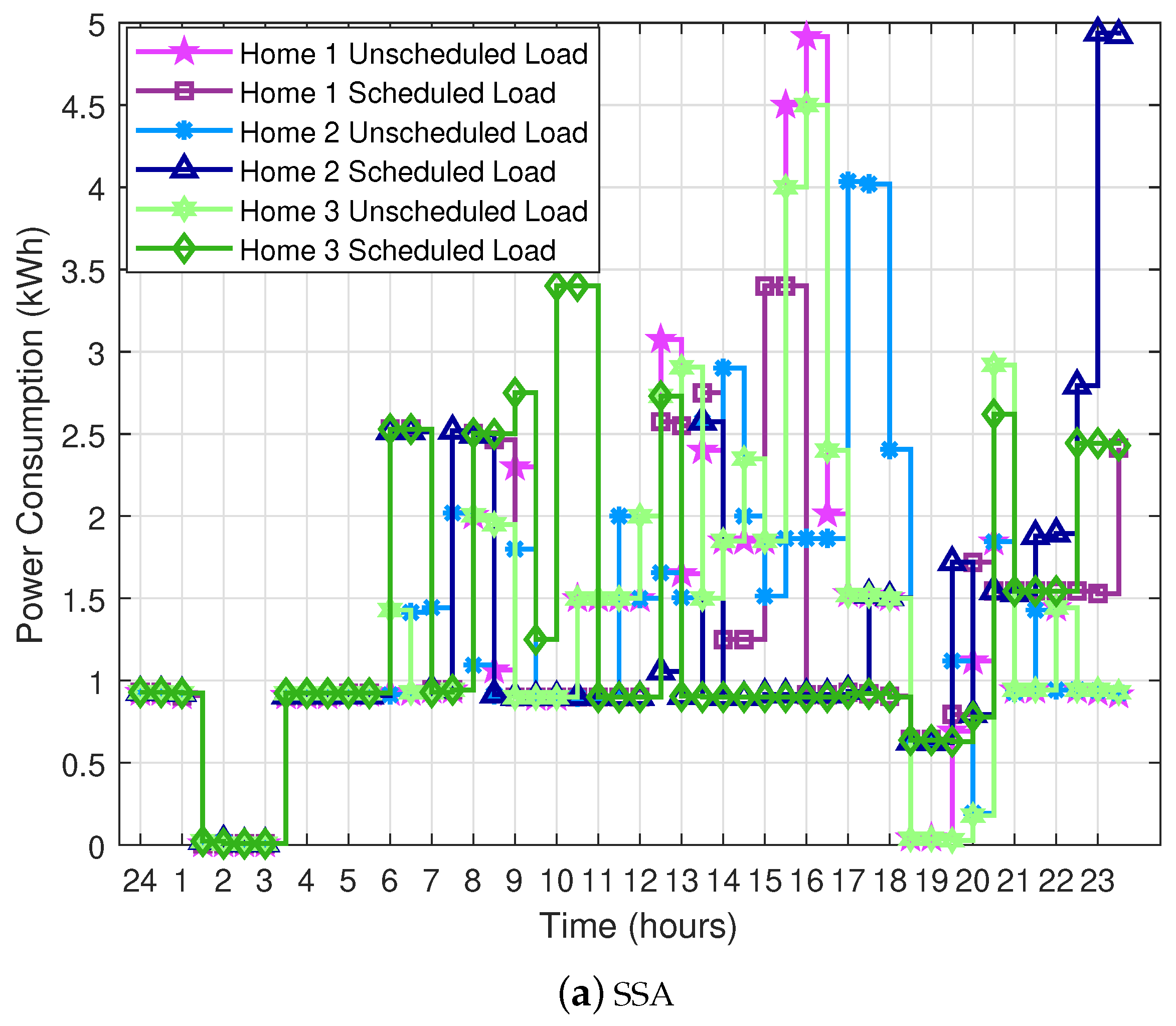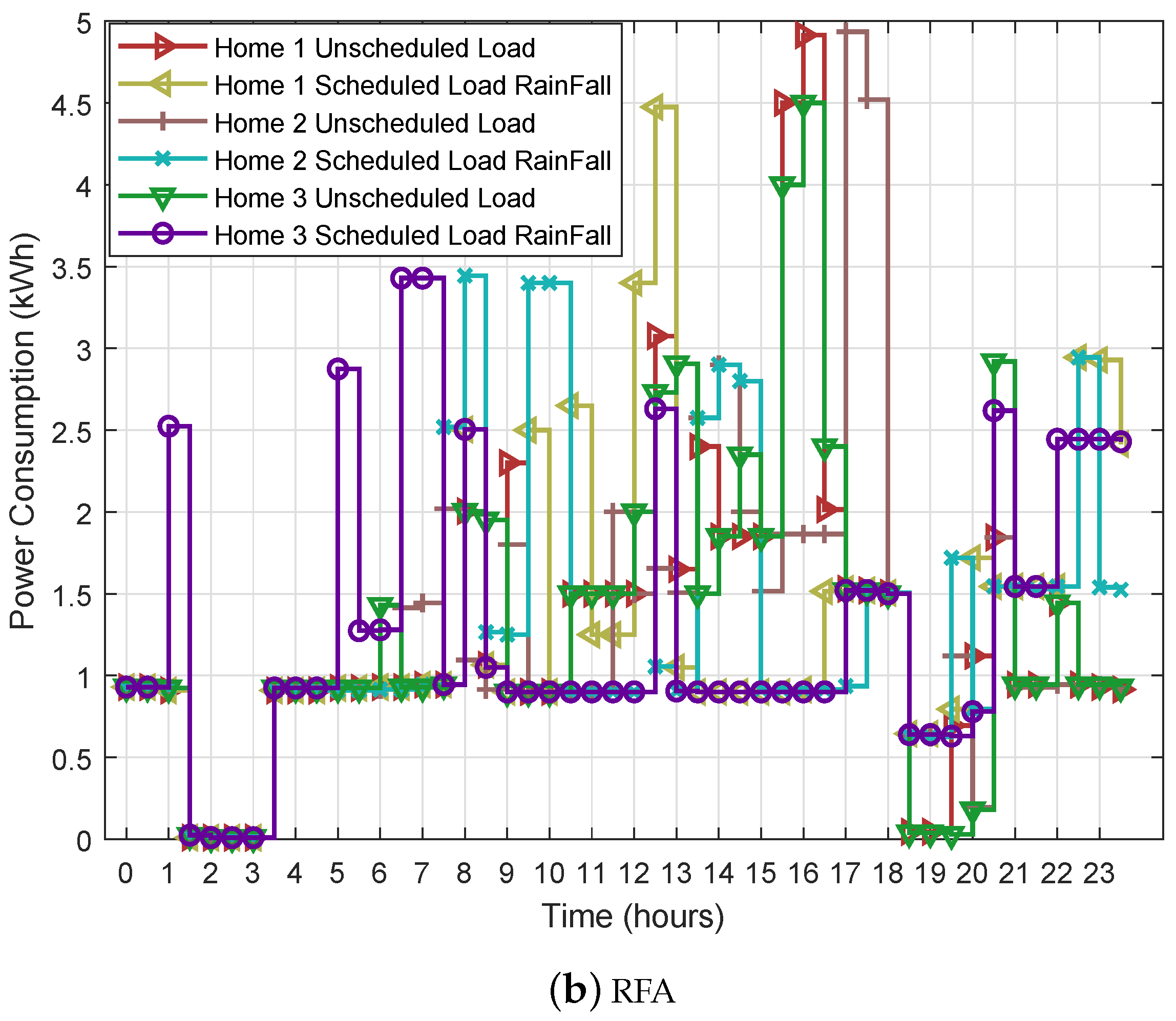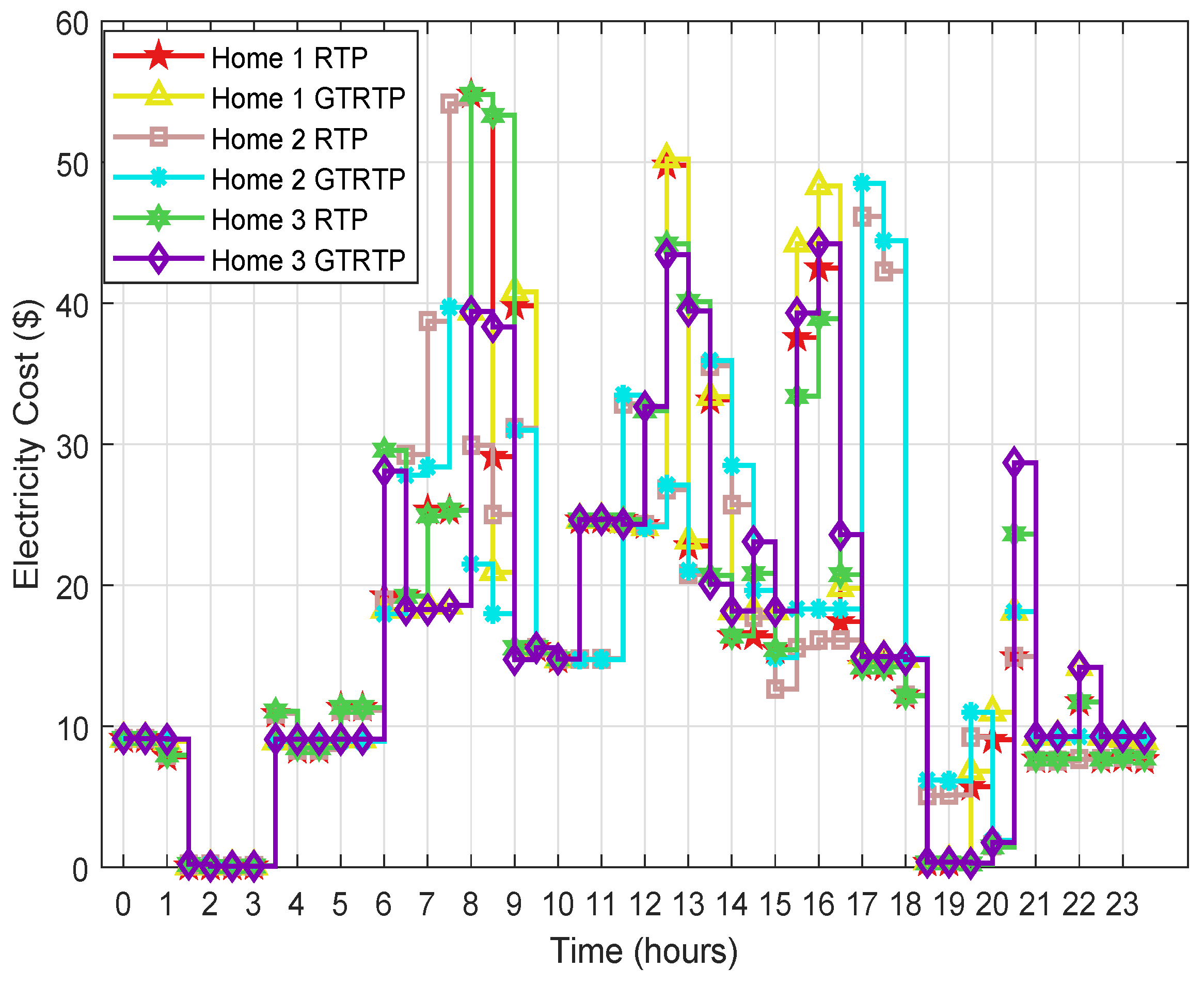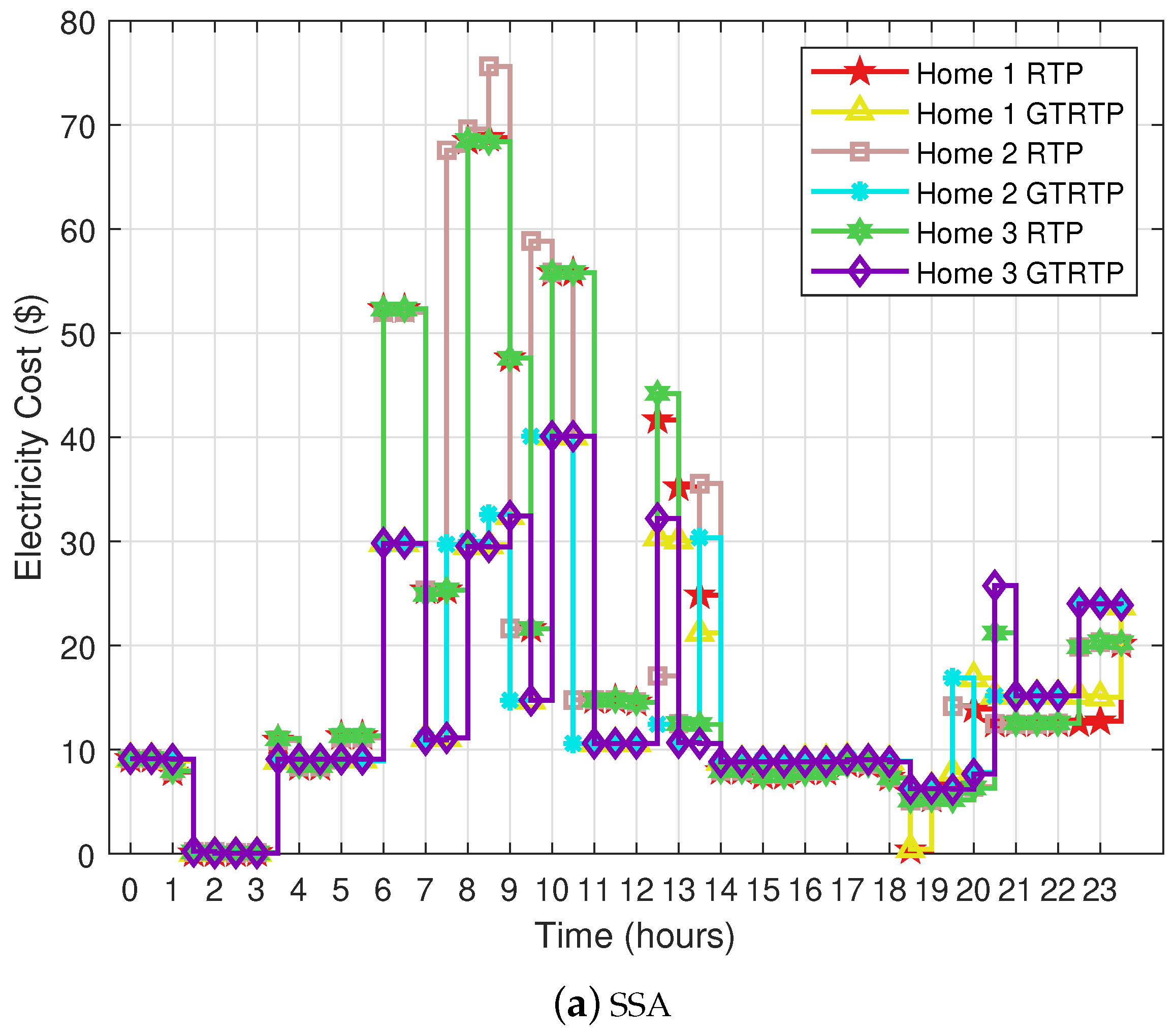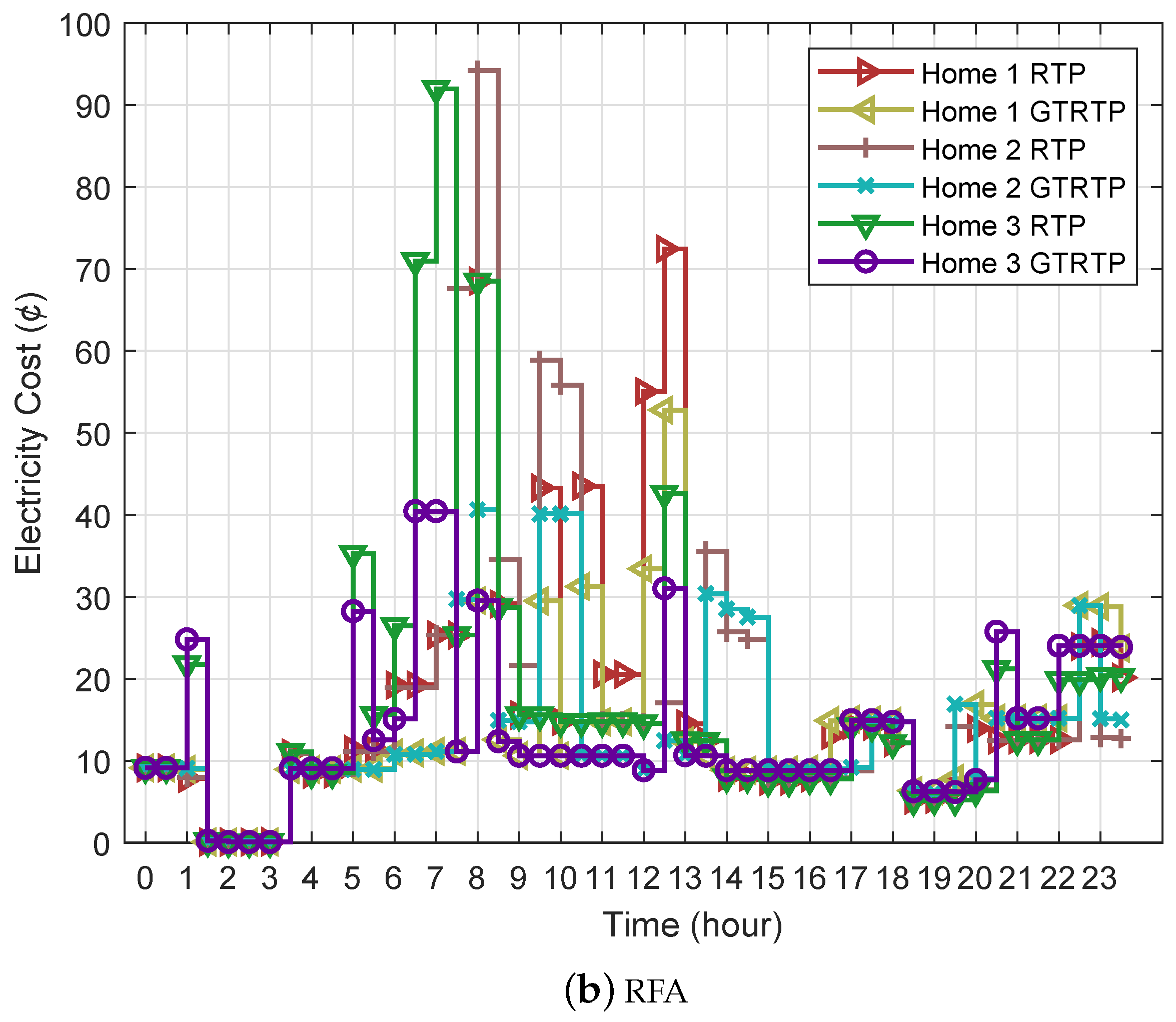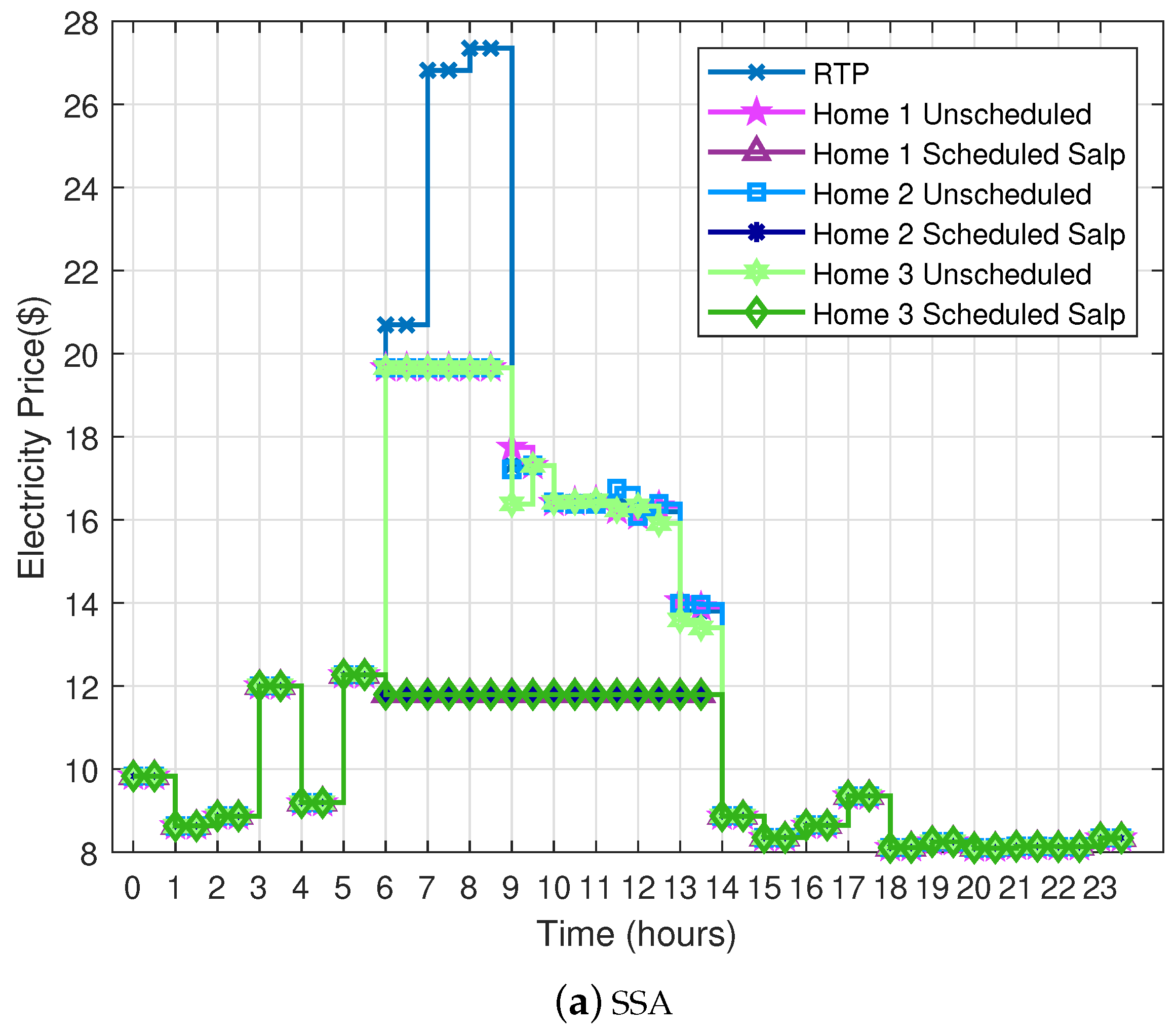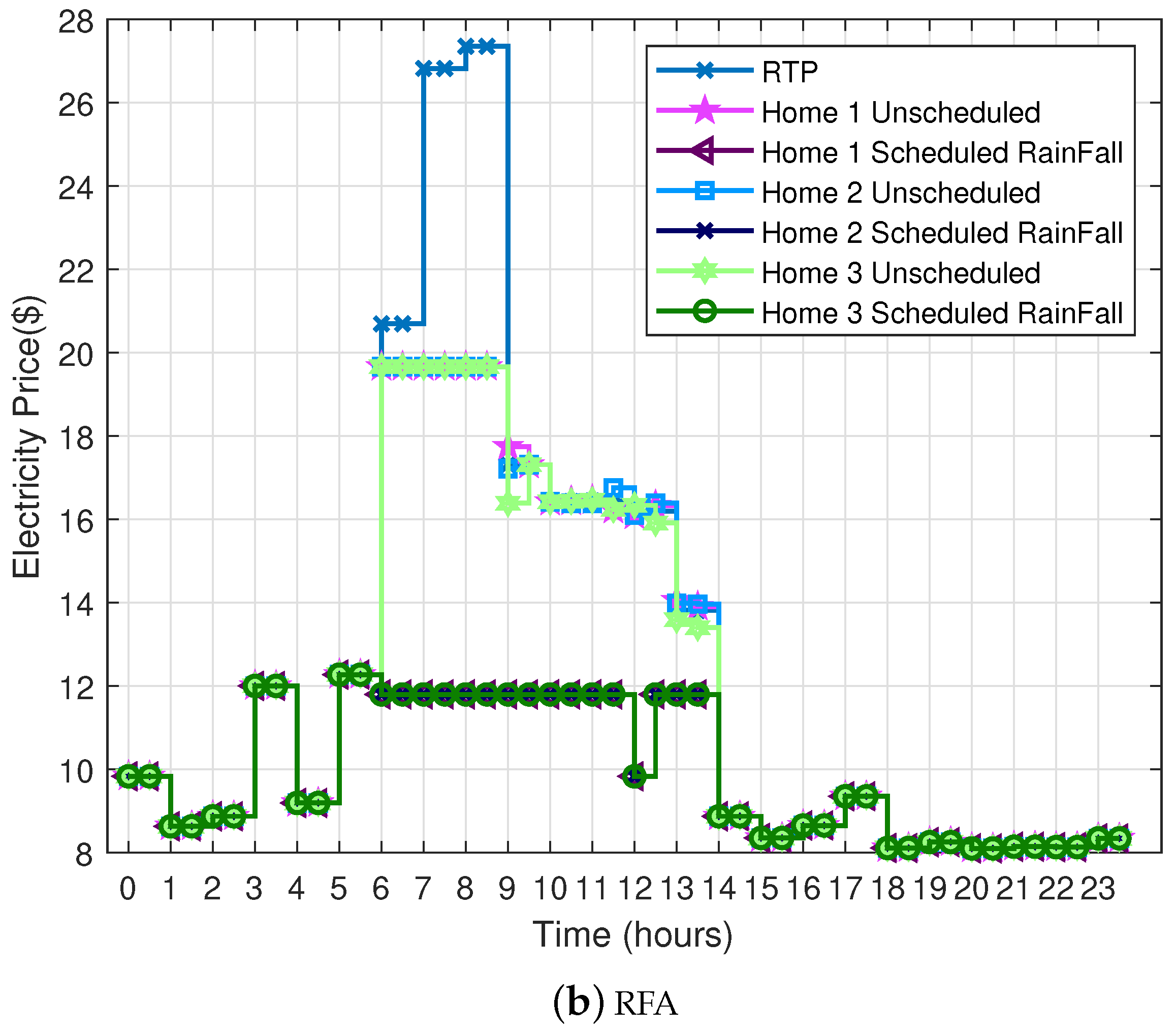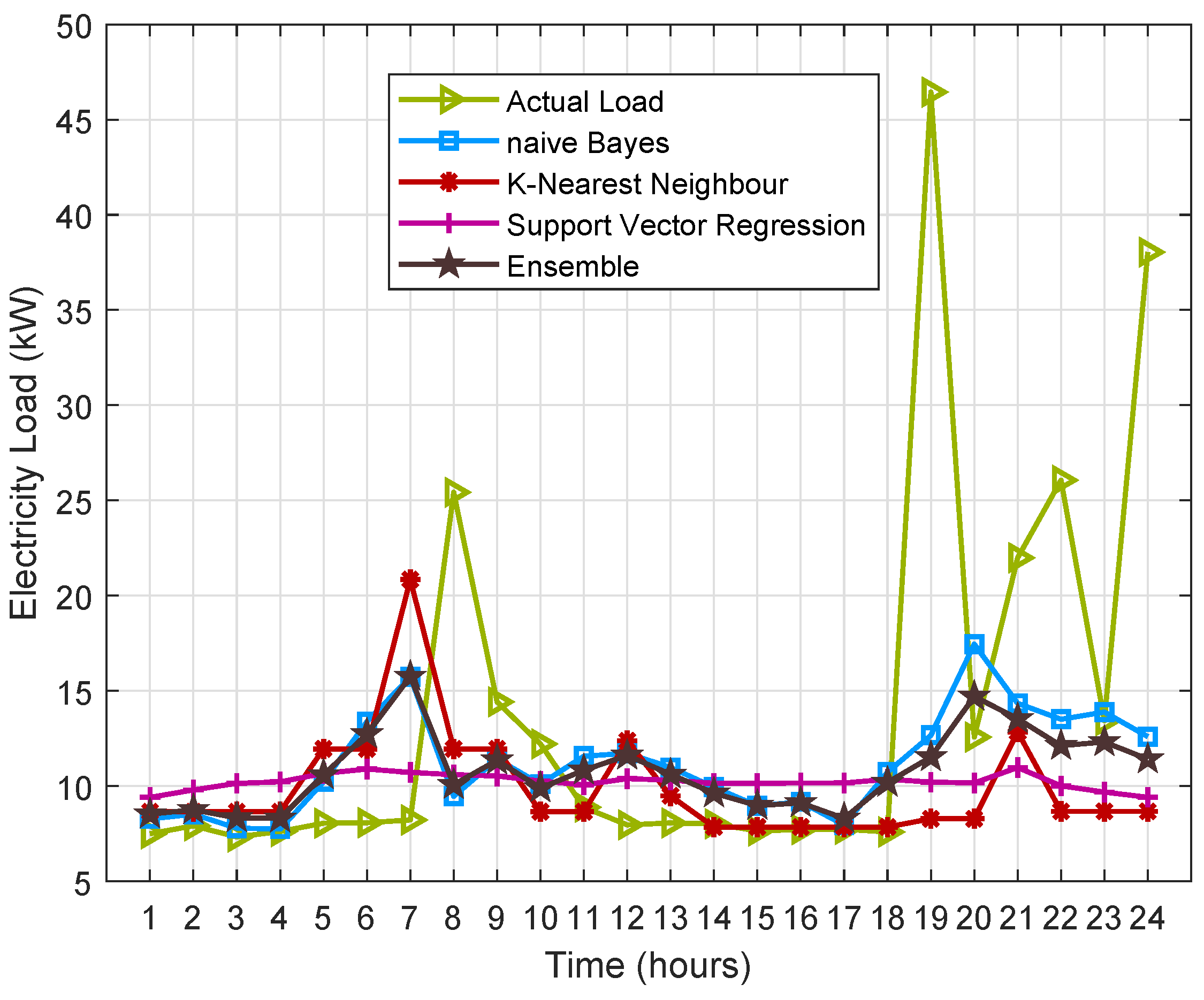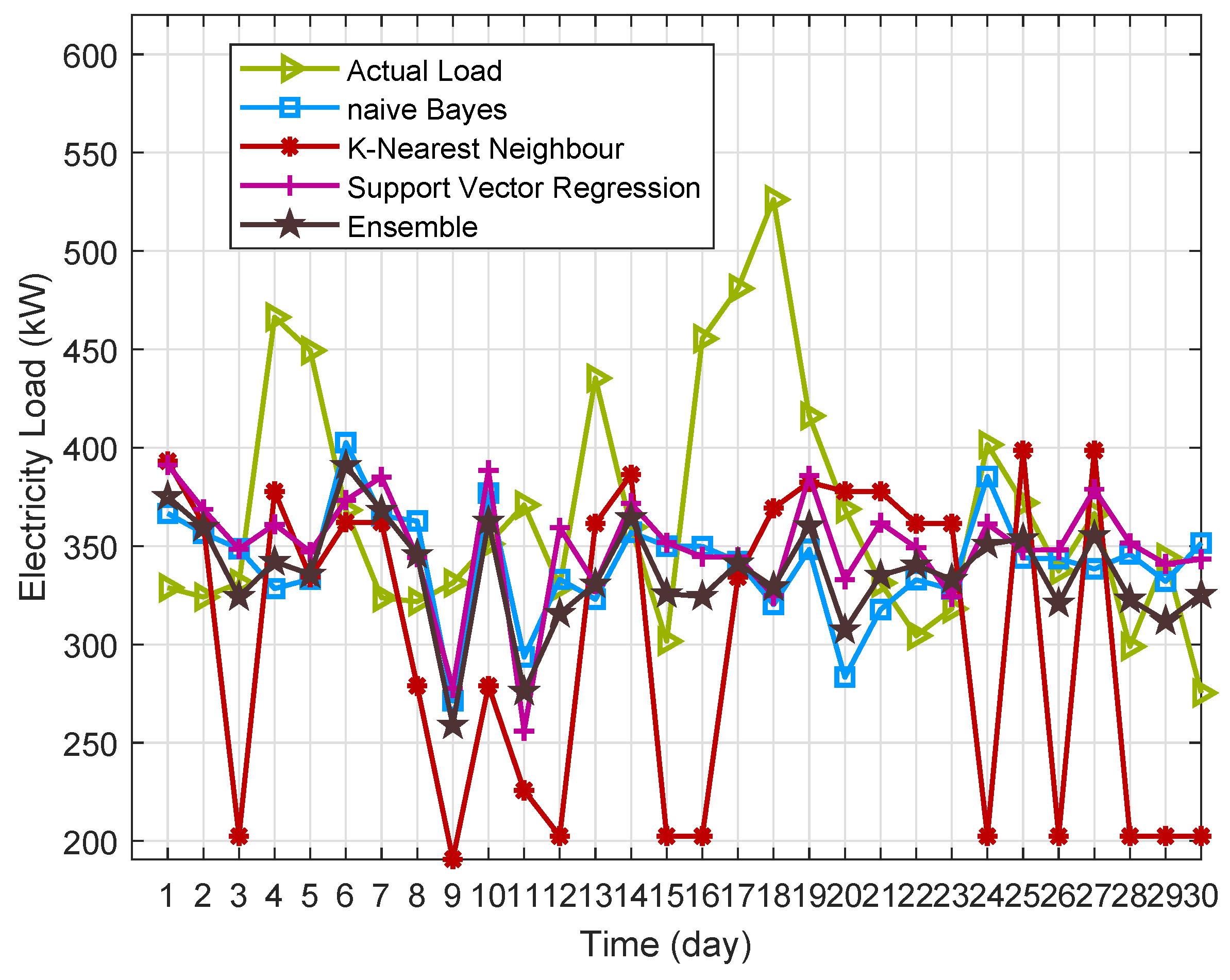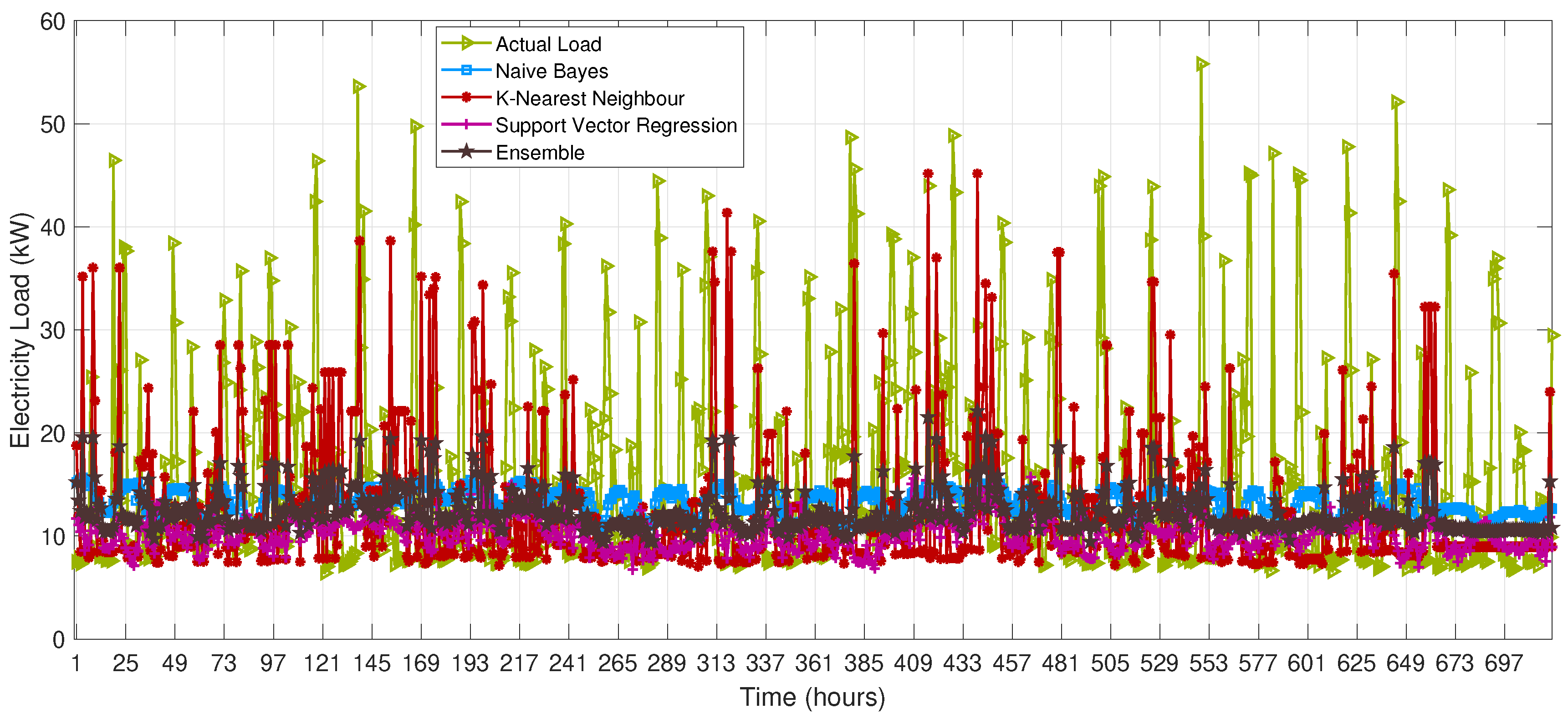1. Introduction
Today, the power industry is the highest producer of electricity to balance demand and supply. The major considerations of the power industry are environmental protection, energy demand and the integration of renewable energy resources. The distributed renewable energy resources are installed to resolve the environmental related issues and energy demand. Moreover, energy generated by these resources is cheap as compared to power plants. However, a backup is needed for constant energy flow because of varying weather conditions which effects the generation of power. As the demand of power changes with the varying weather conditions. The change in energy demand and supply is very common. The Demand Response (DR) program is designed to cope with the load balancing problem. Various pricing strategies under DR program have been introduced in order to overcome the extensive use of electricity during on-peak hours (i.e., increased load demand). The electricity consumers who implement the DR are given incentives for shifting energy consumption to off-peak hours from on-peak hours. Initially [
1,
2] proposed price rates for peak hours. For this purpose, they used variable pricing strategies. Boiteux et al. have presented the fixed price rate according to the consumption of electricity. However, utility charge extra cost, if power consumption reaches the generation capacity. The high rates of electricity during the on-peak hours can manage the load. However, there is a chance of high energy demand during the off-peak hours.
Under DR, linear and non-linear pricing strategies have been designed. Manual pricing strategies are mapped in the linear fashion. In nonlinear pricing scheme, quantity and total price are mapped in the nonlinear fashion. Real-Time Price (RTP), Time-of-Use (ToU) and Curtailable/Interruptible (C/I) pricing tariffs are presented as nonlinear [
3]. Other time-varying approaches ar Variable Peak Pricing (VPP), Critical Peak Pricing (CPP) and Critical Peak Rebate (CPR).
RTP and ToU are widely used pricing schemes throughout the world. RTP varies all the time according to the wholesale price and demand. This fluctuation may discomfort the consumer. The ToU tariff is divided into three blocks: off-peak, shoulder-peak and on-peak hours and prices during these time span remain fixed throughout the season. Utilities (or aggregators; i.e., electricity providers) define price rates for each block (off-peak, shoulder-peak and on-peak) of ToU after observing historical behavior of the users’ energy consumption patterns. As, after collecting the energy consumption patterns of three hundred prosumers in Cyprus, Venizelou et al., in [
4] designed the ToU tariff. However, in our proposed work we modified the already defined ToU price signals in order to provide the incentives to the users who shift the peak load. For this research work, seasonally defined ToU electricity rates are taken from [
5].
Some of the consumers shift the peak load to reduce the electricity cost. However, price rate remains the same even though if the user shifts the peak load. The utilities having CPR rate, pay incentives to the users who shift the on-peak load. The CPR pricing approach is introduced to give the money back to the customers after reducing the energy consumption [
6]. This is applicable only during the critical peak hours. Among all these tariffs, the most widely used tariff around the globe is ToU. However, no economic gain is observed because of zero energy consumption during the on-peak hours [
7].
In this price model, electricity per unit rate for each user is defined according to the increase in power consumption. This is applicable during shoulder-peak and on-peak hours. In the proposed pricing model, coalition-based Game Theory (GT) model is used to distribute the extra generation cost among the users in a specific residential sector. In the proposed price model, GT distributes the generation cost among all the users as a pay-off. Energy management system controls, monitors and manges the user demand according to the energy supply. It could be centralized, decentralized or hybrid depending on the geographical location of the area. In an aggregated residential sector, time-varying pricing scheme, coupled with large-scale energy management system can rebound peak [
8]. Rebound effect is shifting of the load from on-peak to the off-peak hours. Especially, when all the users are subject to the same price (global price policy) [
9].
To cope with this problem, we proposed a constraint-based cost minimization function for optimal scheduling of electric appliances. Salp Swarm Algorithm (SSA) and Rainfall Algorithm (RFA) are used to verify the compatibility of the proposed pricing scheme with energy management system.
Some machine learning techniques are also being studied to investigate the SG related issues. The combined problem of multiple power companies and DR management in a smart gird network is studied by [
10] through reinforcement learning and GT technique.
Problem Statement
Every power generation plant can generate a fixed quantity of power. However, energy demand cannot be fixed. It varies from time to time which destabilizes the utility. DR program is designed to cope with the load balancing problem. Under DR program, price-based tariffs such as CPP, RTP and ToU tariffs are introduced. To minimize the extensive usage of electricity during on-peak hours (i.e., energy demand increases). The DR program encourages the user to shift the load from on-peak hours and get incentives. ToU tariff is the most common pricing scheme amongst others [
4]. The ToU tariff is divided into three blocks: off-peak, shoulder-peak and on-peak hours. Although, ToU tariff can reduce the peak-load of electricity demand. However, almost zero energy consumption is observed during some peak period [
7]. Zero energy consumption means no revenue. To achieve the better performance, an energy management controller is required to schedule the load in mean level. The electricity price for load shifting consumer is the same as other consumers [
7]. A peak-rebate concept is introduced in this proposed work. Where a game theory model is presented to facilitate the load shifting consumers with price incentives. Moreover, to avoid the peak formation during the off-peak hours, meta-heuristic-based scheduling algorithm is presented in this work.
The rest of the paper is organized as follows: related work is discussed in
Section 2. While system model is discussed in
Section 3.
Section 4 discusses the proposed methodology. Simulation results are shown in
Section 5 and conclusion is provided in
Section 6.
2. Related Work
Pricing schemes under DR program are defined to minimize the load on the generation unit. Two predominant electricity price rates are commonly used, i.e., flat rate and dynamic price rate. Prices under flat rates (traditional) remain stable regardless of the rise in load demands. Whereas dynamic price rates (cost-reflective) reflect the true cost of generation and supply. It might be helpful to reduce the load in a smaller region. The main components that influencing the electricity price model are; seasonal price spikes, seasonal volatility and seasonal fluctuation in demand and supply [
11]. Authors in [
11] consider these factors when designing electricity price model. This price model is based on stochastic time change and deterministic feature. Nowadays forecasting methods are introduced in the electricity price model. Authors in [
12] study the long-term seasonal components’ effect in day-ahead price forecasting. Further, NARX Neural Network (NN) model is employed by [
12] for electricity price forecasting. Similarly work on NN-based electricity price forecasting model is proposed in [
13]. At first, the model consists of a two-layer decomposition technique. Thereafter, a hybrid model based on fast ensemble empirical mode decomposition, variational mode decomposition and back propagation NN is proposed. Finally, NN model is optimized using the firefly algorithm. Although, these price prediction techniques generalize the actual electricity price. However, prediction of weather condition and user demand cannot be 100% accurate.
In the literature, several works focus on event-based and time driven pricing schemes while neglecting that environmental conditioning may affect pricing schemes. As a consequence, authors in [
14] inspire from psychology and behavioural economics, design cost-reflective tariffs. These tariffs are applied to the larger cross-section of the population. However, the existing pricing schemes like ToU are defined for two or three blocks, whereas pricing scheme defined on the human stochastic behaviour may not be applicable for the long-term periods. In this regard, ref. [
15] propose the enhanced ToU tariffs in which 24 hours time slots are divided into periods of six blocks. While using this scheme, user can schedule the on-peak load towards the shoulder-peak or off-peak hours. Therefore, no proper mechanism is defined to cope with the peak formation during the shoulder-peak hours, as already these hours have much load.
Work in [
16] designs the ToU tariff that is generated through flat-rates using clustering technique. Besides, the Gaussian mixture model clustering technique is used to group the half-hour time-span tariff and load demand into shoulder-peak, off-peak and on-peak hours. The main drawback of such models is lack of load controlling mechanism that can shift the shoulder-peak into on-peak hours of next day. Decision making another strategy is combined with electricity price model and in this regards, authors in [
17,
18] design the GT-based pricing model. Firstly, work in [
17] uses GT Nash equilibrium strategy to define the ToU price rate for
N time-frame of a day where electricity demand is a key factor that affects the electricity cost. Lastly, electricity price model in [
18] calculates flat and elastic prices. This elastic price varies according to the generation and demand. However, the extra generation cost will be divided equally to each user. This can inconvenience the user who had already shifted his load and has compromised comfort.
Simple time-varying electricity pricing schemes and automated energy management system can rebound peaks in the residential home when each user wants to reduce electricity bill by shifting load from on-peak to off-peak hours [
8]. To deal with this problem, innovative electricity price structures such as Multi-ToU and Multi-CPP are proposed in [
8]. Simulation results depict that proposed pricing schemes smoothen the aggregate demand. Similarly, the peak load of the aggregated load demand problem is also discussed in [
19]. Authors in [
19] propose adaptive consumption level pricing scheme to shift the peak load demand. A case study test results show that the proposed scheme achieves peak load reduction up to 35% and a reduced electricity cost up to 53%. In addition, the user gets a reduced cost up to 53% by curtailing their load. This curtail load scheduled on the next day, which can discomfort the user.
Pricing mechanism is a solution for on-peak load management; however, the scheduling mechanism is required to shift load in a suitable manner. To achieve this, works in [
20,
21,
22,
23,
24,
25,
26,
27,
28,
29,
30,
31,
32,
33,
34,
35,
36,
37,
38,
39] present different load controlling techniques and strategies. For instance, the work in [
20] proposes a Distributed Energy Storage Planning (DESP) for PAR minimization. As first, residential users are allowed to select an appropriate storage space so that balance between the installation and savings is maintained. Thereafter, a Genetic Algorithm (GA) is used for DESP whereas, a GT approach is used for distributed energy management. Moreover, this work also considered consumers’ privacy. Simulations results show that the proposed scheme minimizes PAR as well as consumers electricity bill. The authors in [
21] present an algorithm for peak load reduction with coordinated response using Electricity Storage System (ESS), Photovoltaics (PV) and electric vehicle. In their work, peak load is reduced by observing the residential load of consumer using AMI in real-time. In addition, Artificial Neural Network (ANN) technique for peak load prediction is examined. The authors evaluate the effectiveness of the proposed scheme with Decision Tree (DT) algorithm. Furthermore, simulation results show that taking appropriate coordinated actions, the proposed scheme minimizes the peak load reasonably.
Some machine learning techniques are also being studied to investigate the smart grid related issues. The combined problem of multiple power companies and DR management in a smart gird network is studied by [
10] through reinforcement learning and GT technique. To balance the power and supply [
22] function binding is proposed. Where equilibrium is achieved between competitive and oligopolistic markets using GT. Another article [
23], studied the DR framework, here authors simulated for stochastic environment. For real time scenario, values are taken after forecasting. These studies show the importance of GT model in DR. Further, In [
24], Asif et al. develop a priority-based Demand side management DSM strategy for scheduling home appliances. Three known meta-heuristic techniques namely GA, Binary Particle Swarm Optimization (BPSO) and Enhanced Differential Evaluation (EDE) algorithm are employed. These techniques incorporate SS to solve the load shifting problem in SH. Furthermore, to tackle the problem of rebound peaks and enhance the stability of the grid, the knapsack capacity limit is used. From the simulation results, the cost is reduced by 60%. However, this work considered a limited number of home appliances.
A nonlinear programming model is proposed by [
25]. In this work, the real-time DR model is presented to minimize the electricity cost associated with consumption through appliance scheduling while ignoring consumer comfort. Another article [
26] presents a model for residential users to minimize their consumption cost. It is assumed that all consumers are selfish and they are only concerned about minimizing their energy utilization cost. For this purpose, the work adopts a non-cooperative game theoretic approach to optimize their battery capacity and schedule their electricity consumption. Besides, the work examines bilateral trading between the utility and consumers. In addition, this approach encourages the consumers to minimize their consumption cost and reduces the PAR. The experimental results show that the scheme achieves energy utilization cost reduction up to 5% and PAR reduction up to 50%. The authors in [
27] develop a SHEMS to minimize consumption cost, PAR and user discomfort. In their work, the authors use three known meta-heuristic techniques namely Ant Colony Optimization (ACO), BPSO and GA. For the electricity tariff implementation, authors merge the ToU and IBR pricing signals. In addition, authors combine the RES and ESS. The simulation results show that GA-based SHEMS outperforms BPSO and ACO-based SHEMS in cost and PAR reduction with a tolerable user discomfort.
In [
28], a multi-objective model for DSM is proposed by Dan Li. In his work, the author considers a day-ahead market with a hierarchical framework for the three grid participants namely: DR aggregator, utility and consumers. In his framework, all the grid participants have different objectives. The utility seeks to minimize its operational cost and increases its revenue. Whereas DR aggregator acts as a broker between consumer and the utility. The utility ensures that DSM services will be provided whereas, consumers are assured that the electricity bill will be curtailed if they eagerly participate in DSM programs. To give maximum benefit to all the participants, Artificial Immune Algorithm (AIA) is employed [
28]. AIA uses a Pareto optimal set to ensure fairness among all grid participants.
Ren Shiou Liu [
29] presents a multi-agent-based decentralized mechanism for SHs to share electricity within the neighbouring homes. The mechanism uses two algorithms namely Column and Constraint Generation (CCG) algorithm and Scalable and Robust DSM (SRDSM) algorithm. In addition, RES and ESS are incorporated to meet the electricity demand of the SH. The simulation results show that CCG is effective in cost reduction as compared to SRDSM. Whereas SRDSM outperforms CCG in PAR reduction. However, the performance of CCG is affected by increasing number of SHs. Furthermore, the proposed scheme only relies on solar irradiation for energy production. Therefore, the performance of this scheme is affected by uncertain weather conditions.
To minimize PAR, Vivekananthan et al. [
30] analyze data gathered from several homes. The work uses an incentive-based scheme to reward consumers who actively participate in PAR reduction. However, the authors assume that all the consumers have a similar load profile and usage pattern of the home appliances. Simulation results show that the proposed scheme reasonably minimized the PAR. In [
31], the authors develop a SHEMS to curtail the peak demand by motivating consumers to eagerly participate in the DSM strategies using the ToU scheme. In addition, GA and PSO-based known meta-heuristic techniques are implemented in a typical SG scenario. Furthermore, the authors highlight the advantages of ESS. Experimental results illustrate that the given optimization problem is effectively solved using PSO.
To automatically control and implement distributed DR [
32], the authors proposed Overgrid, a distributed peer-to-peer architecture. Overgrid balances the power demand of its system buildings which belongs to virtual microgird. Qian et al. [
33] proposed DR strategy in SG to minimize PAR. In addition, consumers minimize the electricity bill whereas, the utility plans to get more profits. To derive advantages of DR strategies for all the participates, Simulated-Annealing-based Price Control Algorithm (SAPCA) along with an iterative algorithm for scheduling the home appliances are examined. SAPCA maximizes the profit of utility whereas, iterative algorithm curtails the consumers’ electricity bill. In addition, the income of the utility is increased.
In order to keep the balance in demand and supply, flow updating distributed algorithm is implemented for monitoring the electricity consumption. Another article [
34] presented the teletraffic tool to control the energy load. They proposed control schemes which are tuned to achieve the trade-off among control overhead, usage and privacy leakage. In power system, the utility stability is not only a matter of fact but also consumer satisfaction. Consumer satisfaction usually means minimum cost with maximum comfort. Developing an energy conservation plan at the consumer end can reduce up to 40% annual energy bills [
35] by ensuring the fair level of user comfort. To achieve this goal, [
35] compared the proportional-integral-derivative and Model Predictive Control (MPC) control methods of an air conditioner of a home.
The authors in [
36] develop a SHEMS for scheduling home appliances and power trading simultaneously. It is assumed that each home has its own microgrid and ESS. Moreover, the SH is connected with the utility to trade the deficit/surplus energy on the basis of its requirements. The electricity demand of the SH is directly fulfilled by the MG and ESS. To schedule the home appliances, the work implements Cuckoo Search Algorithm (CSA) and SA. Simulation results show that the proposed scheme reduces the PAR and energy utilization cost. Furthermore, it shows that the performance of CSA is superior to SA in terms of cost minimization and earnings maximization.
Asif et al. [
37] develop a scheme that derives an absolute comfort level for domestic users. In their scheme, the consumer is assigned a unique priority for each appliance on the basis of time and operational properties. It is assumed that the priorities assigned to each appliance vary according to the preferences of consumers. The work uses an Evolutionary Accretive Comfort Algorithm (EACA) with GA to generate an operational schedule of home appliance that yields a maximum User Comfort (UC) with a pre-determined budget. Simulation results report that their scheme achieves a reasonable UC within a small budget. The authors in [
38] present a scheme that enhances UC via renowned meta-heuristic techniques, GA and PSO. The work maintains a specific environment inside an SH. To achieve the desired objective, the authors analyze a dataset recorded over a period of one month inside a laboratory. Experimental results report that the proposed scheme achieves the desirable objective. However, the work ignores PAR and electricity utilization cost.
Bharathi et al. [
39] present a technique to minimize energy utilization cost. In their work, the authors analyze the energy utilization pattern of domestic, commercial and industrial consumers from different data repositories. To minimize the energy consumption cost of consumers, the authors use GA. Experimental results review that GA-based DSM achieves cost minimization as compared to the situation when GA is not used. Although, optimization techniques can be effective for a specific scenario. However, to derive the universal optimal solution is a challenging task. As a consequence, this work proposes a new optimization technique for appliances scheduling to reduce electricity cost and PAR.
3. System Model
Under DR program different electricity tariffs (i.e., ToU, RTP, CPP, etc.) have been defined in order to reduce electricity demand during the on-peak hours. The DR strategy provides the incentive to shift the load from on-peak to off-peak hours. Where prices during the off-peak hours are low as compared to the on-peak hours. The prices during the on-peak hours increase as the demand of electricity increases and the excessive demand is fulfilled by costly energy generation units i.e., (fuel generators). The electricity per unit price is not only about the generation cost; however, there are also some other factors. The main factors that effect the electricity price signals are: generation cost, transmission cost and distribution cost [
6] as described in
Figure 1. The prices are highly influenced by the user demand and utility. Utility is known as service provider, it regulates the electricity rate seasonally (ToU and CPP), weekly, daily or hourly (variable peak price rebate or RTP).
In this paper, an enhanced ToU tariff based on GT (GTToU) is proposed for a residential sector. In this model, each user’ s per unit price of shoulder-peak and on-peak hour is calculated according to the electricity load profile and extra generation cost. Further, the proposed scheme is compared with that of day-ahead RTP. An overview of the proposed system model and information flow between the system components is provided in
Figure 1. The electricity used by the end user passed through different processes. First, the generated energy is transmitted towards the distribution units through transmission lines. In the distributed unit, transformers stepping down the energy voltage to the level used by the consumer and distributed towards the end users through distribution lines. In this work, each home is considered as a smart home. A smart meter and an Energy Management Controller (EMC) are installed at each home. The smart meter acts as a gateway to exchange the information between the utility and a smart home. The EMC manages and controls the electricity load by scheduling the smart electrical appliances. A scheduler installed in the EMC schedules appliances according to constraint(s) defined by the optimization framework [
40]. In this proposed work, utility asks for the user energy demand before the start of the day and it could be one hour before or 5 minutes before. The constraint (threshold level) will be set by the utility and scheduler according to the provided information. In our proposed work appliances are scheduled from on-peak to off-peak hours according to the provided electricity rates and demand through smart meter.
The utility has a price regulator that calculates each user’s shoulder-peak and on-peak price according to the consumed power. The utility also monitors the other costs (i.e., generation, transmission and distribution cost). However, in our scenario, we focus on the users’ power consumption. The price regulator calculates the price using GT and updates the users through the smart meter. Moreover, the user manages the load during the shoulder-peak and on-peak hours through scheduling. Whereas a meta-heuristic-based scheduler is embedded in EMC. In addition, we consider two meta-heuristic algorithms, SSA and RFA.
3.1. Formulation of GTToU
Due to the high demand of electricity during some specific hours, generation increases and has impact on electricity price and user’ s electricity bill. In this section, a mathematical model is formulated to enhance the ToU electricity price signals. In ToU rate, a day is broken up into three blocks: on-peak, shoulder-peak and off-peak. Prices during the on-peak and shoulder-peak hours are high due to high demand and generation units. It is worth mentioning here that each customer is charged the same price even if any of them shifts load towards off-peak hours. In this proposed price rate, each user’s per unit price is calculated during the shoulder-peak and on-peak hours according to the generation of extra energy and users’ consumed electricity. Further, in this section, we will discuss the constrained-based scheduling problem. The focus of the proposed work is cost minimization. Besides, the load shifting from on-peak and shoulder-peak hours to off-peak hours is also done.
3.1.1. Modified ToU Tariff
The modified ToU tariff is based on the extra generation cost and the load demand of user’s during the specific hours. The changes per hour units are made for shoulder-peak and on-peak hours. The formal representation of modified ToU price signal (
) is given as (
1):
where
represents the off-peak hours. Utilities define the price rate according to the demand, where electricity prices are high during the periods of high power demand (on-peak hours) and lower during the periods of low power demand (off-peak hours) [
41]. off-peak hours are usually when homes and offices use less electricity.
In this scenario, we consider on-peak and Shoulder peak as on-peak hours. The h denotes the N number of homes () in a specific area. The value of ℑ depends on extra cost (ß%) rather than the off-peak price, the value of ß% depends upon the extra generated energy. The increasing amount of generation will increase the ß percentage of user per unit charge. The ß% amount will be distributed among all the users within a specific time interval according to their consumed electric energy.
3.1.2. Electricity Cost Minimization
DSM strategy, load shifting is adopted to reduce the electricity cost. EMC is used for home load management and appliances scheduling. However, this load shifting may results in undesirable rebound peaks because every consumer tries to reduce the electricity bill. To tackle with the rebound peak issue, we have proposed a constraint-based electricity cost minimization function. Here, electricity load is shifted from shoulder-peak and on-peak hours towards off-peak hours according to given constraint in Equation (
3). In this equation, a threshold level according to aggregate load of all connected homes is defined for the on-peak, shoulder-peak and off-peak hours. The scheduler installed in energy management controller schedules the load according to the limits of power demand. It also prevents the rebound peak. The objective function of electricity cost minimization is mathematically written as:
Subject to the constraint:
where
denotes standard deviation;
is the total aggregated load of
N homes. Appliances will be scheduled according to the constraint defined in Equation (
3). In this equation, load limits are defined for the on-peak and off-peak hours. This threshold avoids the load to increase from a specific limit which helps in avoiding the rebound peak. The electricity load of an individual home is calculated as:
where
represents the On and Off status of an appliance. The total electricity cost
is calculated as:
The Equation (
9) is formulated to calculate the
.
where
is the list of electricity price signal.
